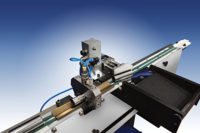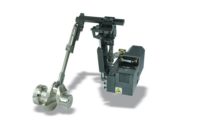Gaging Quality As It Happens
The economies of in-process gaging are realized when high precision is required over large production runs.

State-of-the-art in-process measurement systems can assure grinding machines operate to their best possible capability, creating a system capable of delivering accuracies down to ±0.00001” (0.000254mm). This allows much greater control over the finish grind of critical parts. Source: Jenoptik Automotive

In-process gages should be easy to integrate into the machine tool, set up and install or retrofit to existing machines with control of all measuring functions through a single cable. Source: Jenoptik Automotive

Mechanical crash protection through defined breaking points on the measurement jaws prevent damage to the probe, part and machine. Gage heads should provide large measuring ranges. Source: Jenoptik Automotive

A typical in-process system consists of the following: one or more measurement heads, gap control device, hydraulic or pneumatic slide, industrial controller, and possibly an HMI. Source: Jenoptik Automotive




In-process gaging for this discussion is the continuous measurement of the workpieces during the grinding process in the work area of the machine. The grinding process can be controlled and optimized dependent on the measured parameters. Internal grinding, match grinding, flat grinding on precision parts including shaft, turbo-chargers, pistons, injector components, and hydraulic valves can hardly be successful without an in-process gaging system to measure, collect part data, and provide that information to the machine to optimize the manufacturing process as it is happening. In this way, scrap can be avoided, production interruption can be eliminated, and piece cost can be controlled.
Over the last couple of decades, increasingly higher tolerance requirements have mandated development of in-process measurement systems for O.D. and I.D. grinding applications. These systems locate workpieces, identify and control grinding wheel in-feed rates, measure and control part size, and help compensate for wheel wear. In-process measuring and controlling the machine tool’s operation with that data has greatly improved the quality of the parts produced. This is increasingly important as tolerances on the parts continue to become tighter.
Before the advent of these types of measurement systems, grinding parts was kind of like playing roulette, in that you never knew precisely what the finished size was going to be. The introduction of in-process measurement equipment eliminated gambling from the grinding process, allowing faster production of parts while delivering much better accuracy on the finished product.
Grinding machines have been around for a long time (1800s), with in-process measurement systems having only been around since the mid-1900s. The first systems were analog designs, basically just dial indicator gages mounted on a swing down assembly that had a few disadvantages such as: difficult setup, limited range, bulky, operator intensive, and relatively high costs due to needing multiple systems for each station. At that time, the advantages consisted of faster grinding times, and better accuracy, both of which led to fewer rejects.
Making the choice for quality
A typical in-process system consists of the following: one or more measurement heads, gap control device, hydraulic or pneumatic slide, industrial controller, and possibly a human machine interface (HMI). Up until a few years ago, in-process systems were 100% analog in function and data transmission.
Recently though, new digital systems have become available that eliminate the disadvantages of the analog systems by transmitting data using a digital signal, which unlike an analog signal isn’t susceptible to electromagnetic interference.
Because finish grinding is one of the last processes a part goes through, the part is generally considered to be at almost its highest value when it arrives at the grinding station. Because of this, the importance of in-process measurement systems cannot be overstated; scrap at this stage of the manufacturing process is unacceptable.
When looking for an in-process gaging system, consider the following characteristics:
Consistent measuring accuracy that can provide high repeatability based on thermal and mechanical stability of the gage heads and highest process reliability even for the smallest workpiece tolerances.
Interference-free data transfer due to rugged field bus technology which offers a measure of safety and reliability to the measuring cycles.
Mechanical crash protection through defined breaking points on the measurement jaws, preventing damage to the probe, part and machine. Gage heads should provide large measuring ranges.
Long term stability of all measuring components built into a compact and protected design for use in production. In-process measuring takes place in a harsh environment. Low maintenance and wear-free components are essential.
The flexibility to measure small batch series to large-scale production and accomplish simultaneous measurement of different parameters on one workpiece. A custom-designed system can easily be adapted to various measuring tasks, workpieces and machines for in- as well as pre- and post- process applications.
Easy to integrate into the machine tool, set up and install or retrofit to existing machines with control of all measuring functions through a single cable.
Meeting tougher tolerances
Grinding machines today are quite capable by themselves, having the ability to grind parts to within approximately ±0.00006”, but they can’t do the job alone as tolerances continue to get tighter. State-of-the-art in-process measurement systems can assure grinding machines operate to their best possible capability, creating a system capable of delivering accuracies down to ±0.00001” (0.000254mm). This allows much greater control over the finish grind of critical parts such as fuel injector components, valves, shafts, etc.
Although in-process gaging reduces the need for direct operator input, other factors like changing ambient conditions means the operator must still maintain a certain amount of control over the production environment. Process variables that can be partially compensated for by in-process gaging include coolant temperature (which can affect part size) and work piece temperature (should be stabilized before the grinding operation).
Grinding cycle management is another important way in-process gaging can improve quality and productivity. To save time in a typical grinding cycle, the wheel approaches the workpiece rapidly using a gap control device to prevent wheel over-travel. At some point in the approach, the in-feed rate changes to the coarse grind rate, allowing the machine to remove a predetermined amount of stock. During the coarse grinding process, pressure between the wheel and the workpiece causes the workspace to flex slightly, so the in-process gaging system switches the wheel to a fine grind in-feed rate, which minimizes any part flex that might occur.
The economies of in-process gaging are realized when high precision is required over large production runs. A 100-piece part run is usually the decision point, although as few as one or two pieces could justify in-process gaging if you’re producing complex parts with multiple diameters with a high monetary value. For questions, contact a manufacturer of in-process gaging system for an evaluation of your particular requirements. That way, you can be assured that all of the variables common to any in-process application are accounted for in a system recommendation.
Looking for a reprint of this article?
From high-res PDFs to custom plaques, order your copy today!








